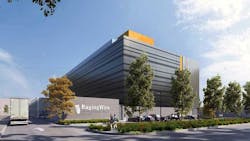It’s been a big year for RagingWire Data Centers. As 2018 draws to a close, the company has taken a big step in its national expansion, announcing that it has bought land for a data center in Santa Clara, Calif.
RagingWire plans to build a 16-megawatt building on a 3.3 acre site on Walsh Avenue, providing it with a footprint in the strategically important Silicon Valley market. It’s the second new market of 2018 for the company, which also acquired property for a campus in suburban Chicago.
Given the difficulty of acquiring property in Santa Clara, the deal is a key step in realizing RagingWire’s ambition to create campuses in America’s largest data center markets.
“This is an important milestone in our company’s history,” said Doug Adams, President and CEO of RagingWire Data Centers. “With the addition of Silicon Valley to our portfolio, we now have data center options in the top three data center markets – Ashburn, Silicon Valley, and Dallas – plus land for build-to-suit data centers in Chicago, the number four U.S. data center market.”
More Space in a Constrained Market
RagingWire’s entrance into the Silicon Valley is notable on a number of fronts. It will bring more data center inventory and more competition to Silicon Valley, which is one of the largest and most important data center markets in the U.S., but also one of the most difficult places to build new data centers. The company is also using an earthquake-resistant design, and building vertically to make the the most of its real estate.
Santa Clara is the prime location for data center site selection because its municipal utility. Silicon Valley Power offers rates are meaningfully lower than the cost of power from PG&E in surrounding towns. But development sites have grown scarce in Santa Clara, prompting data center developers to seek sites with existing buildings that can be demolished to make way for data center campuses.
“The supply of wholesale data center space in Silicon Valley is constrained,” said Kelly Morgan, Vice President at 451 Research. “Many providers no longer have room to expand, and it is difficult to find suitable land with the necessary power and environmental characteristics needed to obtain permits. New data center space in Silicon Valley, particularly Santa Clara, is typically leased before it is available and commissioned.”
Vantage Data Centers, CoreSite and Digital Realty have all expanded by acquiring sites with existing structures and knocking them down to make way for server space. Meanwhile, both CoreSite and Vantage are building four-story data centers to get the most capacity possible out of their existing real estate.
RagingWire will follow suit, with a four-story facility that it plans to bring online in mid-2020. IT will be RagingWire’s first facility taller than two stories.
Engineering for Earthquakes
Of course, RagingWire is not a newcomer to the California market, as the company was founded as a colocation provider in Sacramento. In 2012 the company began a strategic expansion into the wholesale data center space and built its first data center in Ashburn.
Japanese telecom giant NTT acquired an 80 percent equity stake in RagingWire in 2014, and bought the remainder of the company in 2017, when Adams was elevated to CEO after 16 years in a variety of leadership roles. RagingWire became part of NTT’s global network of 140 data centers, with the financial resource to target new markets. In 2017 the company opened new campuses in Dallas and Ashburn and grew by 21 percent, Adams said, benefiting from the rising demand for data center capacity in major markets.
With SV1, RagingWire is using a data center design optimized for hyperscale cloud companies and large enterprises. The 160,000 square-foot, four-story facility will yield 64,000 square feet of data floor space and 16 megawatts of critical IT power.
An illustration of the seismic base isolation system RagingWire will use in its Santa Clara data center design. (Image: RagingWire)
The largest natural hazard threat in the Northern California market is earthquakes. That’s why RagingWire will employ a seismic stability system that reduces shocks from earthquakes. This feature, known as a base isolation system, uses a combination of subterranean pendulum isolation and viscous dampers to protect the building and everything inside it.
The same base isolation system was used by RagingWire’s parent company, NTT Com, to save its data centers in Tokyo, Japan from damage during a 9.1-magnitude earthquake and tsunami in 2011. While a differentiator, this is not unique, as a similar system is used in San Francisco by Digital Realty, which employs a base isolation system at its 365 Main colocation center.
About the Author



